"[The black hole] teaches us that space can be crumpled like a piece of paper into an infinitesimal dot, that time can be extinguished like a blown-out flame, and that the laws of physics that we regard as 'sacred,' as immutable, are anything but."
-John A. Wheeler
To an astronomer on any other world, the most important object in our Solar System wouldn't be the Earth, but rather our Sun. Just one example of the hundreds of billions of stars in our galaxy, our Sun is a G-type star, burning at around 6,000 Kelvin and with a lifetime of around 10 billion years.
But stars come in a great variety of masses, sizes, temperatures and lifetimes.
Although they are the rarest type of stars, the bright blue O and B stars are perhaps the most spectacular in all of existence. With masses reaching, twenty, fifty, or even hundreds of times the mass of our Sun, these stars burn hotter and faster than our Sun ever could. Emitting energy often at rates in excess of 100,000 times our Sun's, and frequently living for less than even one million years, these stars build up massive cores through nuclear fusion, and then have no choice but to collapse under the irresistible force of gravity.
Not, mind you, to contract into a white dwarf star, like our Sun will, but to destroy the individual atoms making up the star itself. In the most extreme cases, the stellar corpse will collapse into a black hole: an object so dense not even light itself can escape from it.
On its own, you'd probably never even know a black hole like this existed, given the fact that it's likely going to be thousands of light years away. But every once in a while, we get lucky.
If a black hole happens to have a binary companion -- particularly a large-sized binary companion -- it can steal some of the mass from this much less dense star. When it does so, it not only forms an accretion disk around the black hole, but the matter can get accelerated by the black hole's powerful magnetic fields, and shot out in a pair of jets, perpendicular to the disk, moving in opposite directions.
This acceleration, like all charged particles accelerated by magnetic fields, will cause the emission of light. Not visible light, mind you, but in the case of black holes, powerful X-ray light.
In our own galaxy and very nearby, we've detected a few black holes like this, where the mass of the black hole is only a few times the mass of our Sun. For example, GRO J0422+32, for which an artist's impression is shown, above, has a black hole maybe 10 times the mass of the Sun, and is located about 8,000 light-years away.
One characteristic of these little black holes is that these powerful X-ray sources emit their energy in great bursts, which die down after a few years to become incredibly quiet. The other types of black hole -- the supermassive ones at the centers of galaxies -- do not do this at all!
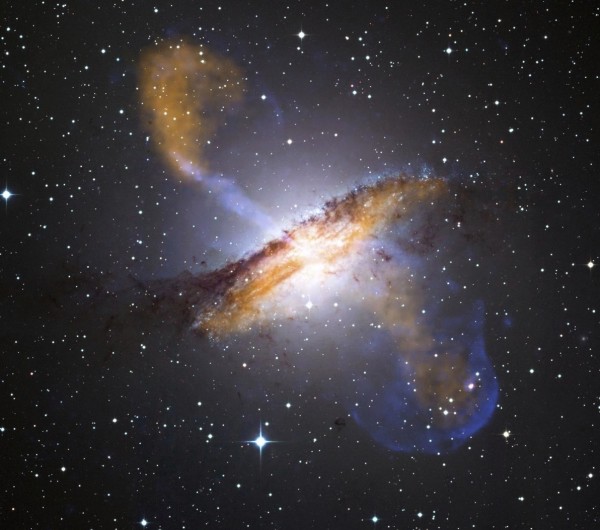
Image credit: X-ray: NASA/CXC/CfA/R.Kraft et al.; Submillimeter: MPIfR/ESO/APEX/A.Weiss et al.; Optical: ESO/WFI.
Centaurus A, located about 11 million light years away, is a giant elliptical galaxy with an unusual dust lane in it. It's also one of the closest active galaxies to us, with two radio jets extending for about a million light years in space, moving at speeds of about half the speed of light in the innermost regions. Needless to say, with this kind of power behind it and a supermassive black hole that's many millions of times the mass of our Sun, these X-ray emissions aren't going anywhere for quite some time.
But a much smaller black hole -- even though it would be much less luminous to X-ray eyes -- can have its intensity drop by a factor of hundreds or even thousands within just a single year, if you happen to be watching at the right time. So far, we've found many stellar-mass-scale black holes this way, but nearly all of them have been within our own galaxy, and none of them have been as far away as Centaurus A.
But let's take a look at Centaurus A itself, in the X-ray.
Yes, the central, supermassive black hole and its jets are easily the most prominent feature in this image, but there are other bright X-ray sources, too. So you don't just look at it once, you look at it many times, separated by long periods of time! What did we find when we did exactly that?
The team used the orbiting Chandra X-ray observatory to make six 100,000-second long exposures of Centaurus A, detecting an object with 50,000 times the X-ray brightness of our Sun. A month later, it had dimmed by more than a factor of 10 and then later by a factor of more than 100, so became undetectable.
That would be this object, above. It makes you wonder, of course, what all of these other bright X-ray sources are! Are they also small-ish black holes, ready to drop off in brightness as soon as their fuel is spent? Or are they more robust, long-lasting objects?
But make no mistake, this object just became the most distant, stellar-mass black hole ever discovered! Want some more proof? Take a look at this 2001 X-ray image of Centaurus A, and notice a very suspiciously missing point of light!
So, if you want to know where the first stellar-mass black hole located more than 10 million light-years from Earth is, it's right here!
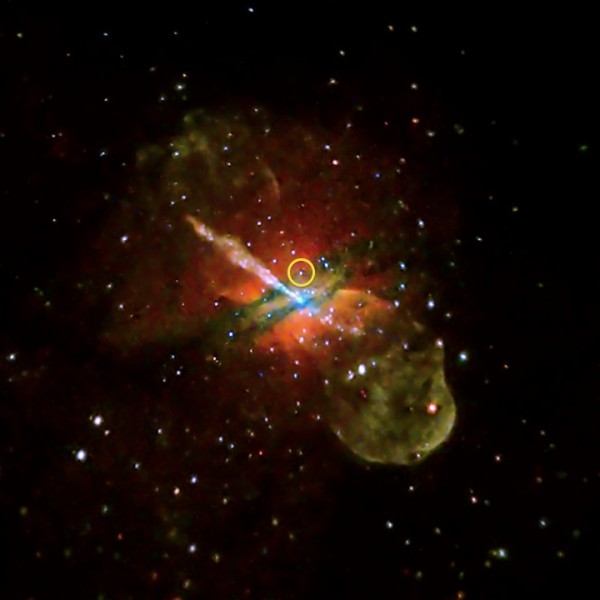
Now, that's what I call a little black hole going a long way!

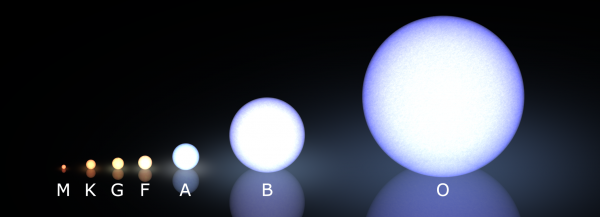
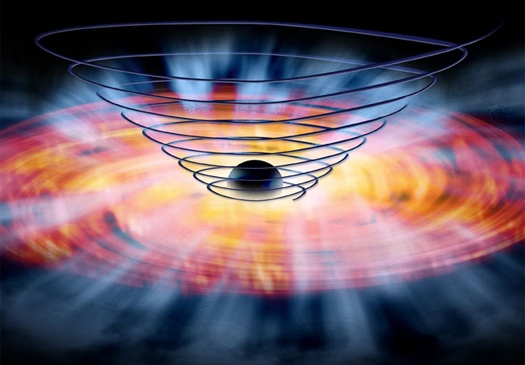
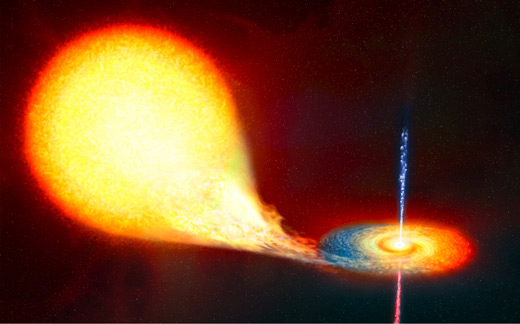
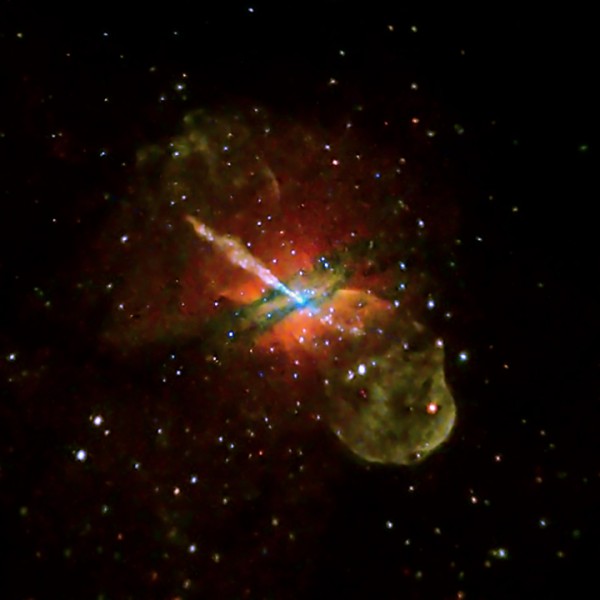


Awesome article. I am following your blog because it has so much information and the more I know the more I can teach my daughter, she is a 6 year old science buff and we recently bought a Celestron 130EQ with a 3X barlo lens and 4, 10, and 15mm lenses. I am still trying to grasp the concept of a black hole. There is so much gravity but at what point does it loose gravitational pull or get filled up to the point that it becomes mass and not a black hole? It can't absorb light and everything else forever because the universe would have been sucked in eons ago. Also, I was taught black holes were theory but you obviously have photographic evidence, I guess astronomy has changed in the last 10 years. Keep the information coming, I find everything you write fascinating because I can understand. You make me think. You are a great teacher! Thank you.
A bit off topic, but I have a question about magnetic fields.
Moons planets suns (and the holes some of them leave) and galaxies all have poles. Within a galaxy is there a pattern to magnetic pole -- what -- orientations of the celestial bodies?
If there is, wouldn't that sorta define up and down?
@1 fishhead
Someone here can give you a more technical explanation, but I will try in layman's terms.
1. You can imagine a black hole as a sphere, not as a point or hole. Google Schwartzschild radius and Swartzschild black holes. Or check wikipedia.
2. Gravity looses it's strenght with distance squared, so it's not like a black hole, or any other object will suck in everything from everywhere. There is a supermassive black hole in the middle of our galaxy, and has been there probably since our galaxy formation, yet we are here, and so is everything else in our galaxy.
3. If i.e. you remove the sun from our solar system and replace it with a black hole of same mass/gravitational pull as our sun, nothing would change in our solar system. All the planets would still orbit it like they orbit the sun.
Bad things happen only when you cross the so called event horizon. Then there's no way out, for light, for matter, for anything. Outside of event horizon everything is ok, you could orbit a black hole just like satelites orbit the earth.
4. The only hypothetical way of black holes diminishing is through so called Hawking radiation. Now don't ask how can it emit something when not even light can escape :) It has to do with some fancy math and quantum mechanics. But it's only a theory. And it only works with very small black holes. If it works at all. Because even a small black hole, the mass of our sun, would absorb cosmic microwave at a greater rate than it would radiate Hawking radiation. We don't know if Hawking radiation actually happens or if it's only a theoretical construct.
As for existance of black holes vs. theory. They do exist. We know that now. The one in the center of our galaxy is being studied (among others) and the stars are orbiting at huge speeds something that occupies very small space and is not visible. If it's not a black hole then it's something even more bizzare. :)
So what was it that makes earth mundane and sol exceptional?
@4 Thomas
Not sure I understand what you're asking? Nothing makes sol exceptional or earth mundane. If you're asking why I said: "... replace sun with black hole of the same mass". No particular reason. The statement would be valid for earth, mars, sirius or any other celestial object as long as the mass is same as the object in question.
Astronomers use our Sun's mass as 1 solar mass unit, and then use that to represent masses of other larger objects. It's an agreement, nothing more. Sun is the most massive object in our system by far, so that's the only reason. Would need much more zeros at the end if they i.e. the mass of Venus or Earth.
I was just wondering about, "To an astronomer on any other world, the most important object in our Solar System wouldn't be the Earth, but rather our Sun."
"To an astronomer on any other world, the most important object in our Solar System wouldn't be the Earth, but rather our Sun."
Turning things around: here on Earth astronomers are intensely interested in finding out about planets around other suns. The ultimate goal is to find out how many suns have habitable planets.
So arguably to most astronomers the planets are more interesting than the suns. Chances are the same goes for astronomers on other worlds.
Of course, what Ethan refers to is that as the Sun is by far the heaviest object of the Solar System everything else is revolving around the Sun.
@6 Thomas
Ahh. I see. Don't know why Ethan phrased it that way.
"With masses reaching, twenty, fifty, or even hundreds of times the mass of our Sun"
Heh. One of my dissertations for graduate Physics with Astrophysics was about supermassive stars (one contender being a name I can't remember with two major companion stars totalling 220 solar masses, the larger one maybe 160). I got a D+ for it because
a) the prof making the title was a supermassive black hole afficionado and I'd stated right at the beginning that this was about supermassive stellar objects, not black holes, and they marked me down for not including anything about supermassive black holes
b) the prof making the title was one of those who DID NOT believe that there was any possibility of a star gaining luminal stage if it weighed more than 40-60 solar masses, it would have to immediately turn into a black hole by the time it reached fusion density.
I had remembered reading something about this waay back in school, maybe 14, and thought it a lovely way to read up on PROPER literature on the subject and pretend it was "work".
"So arguably to most astronomers the planets are more interesting than the suns"
In that it would start an argument? Yes. In that such a proposition is supportable? No.
The search for life-bearing planets is one way of sexing up astrophysics.
It saw a big surge when we first had the ability to find hot jupiters, because that *proved* planets existed around other suns, and again when we could find cold jupiters that proved a solar system with a massive gas giant like ours existed. And it will again when we get the ability to note earth-sized warm planets that could support life.
And if we manage to live long enough to view a planet directly, again.
But that is because these are notable events, not necessarily interesting (for the physics) ones.
But the main interest, if not the main search, is stellar. We can see what OUR sun will do. We can check our theories about stellar evolution and look at the shape of the entire universe.
Planets can't tell us anything about anything other than planets and in the future, the chances of life already being out there.
"3. If i.e. you remove the sun from our solar system and replace it with a black hole of same mass/gravitational pull as our sun, nothing would change in our solar system."
It WOULD get quite a bit colder, mind.
I blame Disney's "The Black Hole". If you're in orbit, you don't have to keep your engines on to stop being sucked in. Only if you're dumb enough to plant yourself on a non-orbit trajectory do you have to do work to keep out.
But it doesn't make for a climax to a movie about a station in orbit around a black hole...
"Bad things happen only when you cross the so called event horizon."
And not even then.
As you near the centre of the event, the event horizon retreats: you can see closer to the singularity. Rather obvious if you remember that the Schwartzschild radius is the event horizon for photons getting to infinity.
You're a lot closer than infinity. And, if falling in, even closer.
What WILL cause problems are the gravitational tides. The G on your head, further away, is different from the G on your feet, closer in.
And the difference gets bigger and bigger as you fall in.
At some point your body can't hold on to its feet and its head at the same time and you go "splurt". And even if you're made of adimantium at some point the event horizon for your head will be closer to you than your feet are, in which case, you have still lost your feet as far as your head is concerned.
There are mathematical solutions to the system that indicate that a rotating black hole will allow you to pass through even the singularity.
But reality doesn't have to follow our maths. It's just a model of the reality, not the reality itself, though in many cases (see evanescent waves and lamb shift), reality acts as if our maths were really real, therefore can be called "reality" as far as we can know it.
"And it only works with very small black holes."
No, it works on all black holes (if, indeed it works at all, but if it didn't, then the laws of thermodynamics are wrong), but the rate of "evaporation" depends on the area of the event horizon whilst the size of the event horizon reduces as the black hole evaporates, increasing the rate of evaporation.
Small enough and the black hole evaporates fast enough to look like a BOOM.
And the escape happens because virtual particles come into being paired, but if one falls inside the event horizon, the pair doesn't have a binding with it any more and gains the energy of that loss.
The black hole gains whatever it swallowed but the pair particle has been given extra energy, possibly enough to escape.
And the sharper the curvature of the event horizon's gravity well, the more energy is given and the more likely you'll get a complete separation.
The whacky maths comes in to how this will tend to mean the antiparticle gets absorbed more than the particle. And, since the black hole is normal matter, absorbing the antiparticle means the black hole loses mass.
This was "required" because otherwise the black hole decreases entropy: any particle falling in has a positive entropic content, but loses ALL information (apart from its gravitational effect) on passing the event horizon. That means no entropy on the black hole, since that requires information on the state of its contents. So when it swallows a particle, the entropy of that particle is now lost, and the total entropy of the system has been reduced.
In this universe we obey the laws of thermodynamics!
Unless the black hole HAS an entropy. But the only place you can fit one is on the event horizon. Which means it has a temperature. Which means it has to radiate.
"It WOULD get quite a bit colder, mind."
heheh.. That it would indeed :)
@12 Wow
""And it only works with very small black holes."
No, it works on all black holes"
Yes, the mechanism works on all (if it works), we agree. I said it in context of diminishing, since Fishhead asked if there is any way of black hole to dissappear. So only very small mass black holes would "evaporate" through Hawking radiation.
Ethan
Nice summary.
Wow
Thanks for the education.
Let me now ask a black hole question.
From time to time I've read things like:
"spacetime reverses inside a black hole" or
"inside a black hole time becomes space-like and space (i.e. r) becomes time-like"
I can't find a good quote or else I'd reference it.
So my question, what do these kind of statements mean. I'm not asking for any fringe interpretation. Does standard general relativity give any meaning to such statements? Or is there some credible working hypothesis in which such statements make sense?
Thanks for any insight.
@OKThen:
Warning, it was a while back for me, so feel free to correct me.
Are you familiar with Minkowski diagrams? Those operate with space and time on 'orthogonal' axes, and are used to relate the time/space co-ordinate systems of objects moving at different velocities. As an object moves faster (relative to another), its space and time axes each move towards the 'speed of light', which is the 45-degree angle between them.
Applying this directly to general relativity is a gross oversimplification, but the basic idea that the arrow pointing straight 'forwards in time' is different for different observers is true in both general and special relativity; as are the arrows pointing 'simultaneous' which are perpendicular to time from the point of view of the local observer, but not necessarily for other observers.
(It's worth noting that the Interval value between two events in special relativity, a constant agreed upon by all observers, is sqr(x^2+y^2+z^2-(ct)^2). Note particularly the minus sign in there. The Interval is a complex distance with space as the real component and time as the imaginary component. If the root is real, there is a space-like Interval between the two events, so they cannot 'see' each other because light could not get between them. If the root is imaginary, there is a time-like Interval, and one event happens explicitly before or after the other.)
General relativity does give meaning to these statements, and in fact that was part of Schwarzschild's original solution that led to the theory of black holes in the first place. The space-time axes can be rotated in the presence of gravitational fields (see 'frame-dragging' and other effects, and in the case of a black hole, they get rotated past the light cone. Time becomes space, space becomes time, and 'forward into the future' becomes 'towards the center of the black hole'. Meaning that escaping an event horizon is mathematically equivalent to time travel.
(And as for time travel, the same general relativistic effects are responsible for the idea of a Tipler cylinder, which produces a time machine from an infinite rotating mass.)
@16 Jenora
Thank you much.
There's nothing for me to correct. If someone else can add to this explanation thank you too.
But this is the explanation that I was thinking about: I haven't heard it as clearly as you explained. I'll reread your explanation and try to understand it more. As well you've given clear enough explanation that maybe I can find other references.
Thanks again for your clear explanation. Nice!
@16 Jenora
Following up on your clues I've come up with two interesting links. http://nrumiano.free.fr/Estars/int_bh2.html
And here, ""Around a spining black hole, space and time behave in such an odd way; space becomes time, time becomes space, and the whole space-time is acutally dragged around the black hole, becomes twisted around the black hole," Professor Thide explained." http://www.bbc.co.uk/news/science-environment-12434007
So it does seem that the Kerr type black holes and the Godel universes ( and tipler Cylinders, I hadn't heard of them, Nice) are the important spacetime situations where time and space switch.
But I'm not catching onto something; my intuition and reasoning are missing something. I need to play with the geometry and the mathematics a bit.
Anyway thanks for breaking my mental block; before your explanation, i couldn't find any credible references.
I love the comments as much as the post!
"since Fishhead asked if there is any way of black hole to dissappear. So only very small mass black holes would "evaporate" through Hawking radiation."
***All*** black holes will evaporate through Hawking radiation.
Small ones quickly, large ones slowly until they shrink to become small ones, where they will shrink quickly.
Unless the black hole is infinite in size, it WILL evaporate. Just very slowly (with a lot more needing to evaporate, therefore exponentiating the relative rate of radiation).
"From time to time I've read things like:
"spacetime reverses inside a black hole" or
"inside a black hole time becomes space-like and space (i.e. r) becomes time-like"
I can't find a good quote or else I'd reference it.
So my question, what do these kind of statements mean."
To an observer outside the black hole, as something (or some poor bugger) falls toward the event horizon, they stop moving through space but are moving differently through time.
I guess it's a bit of sloppy reasoning to lead from that to your statement by noting that normally we're free to move through space but not time at a different rate.
It's about the best I can think of.
@Wow
"**All*** black holes will evaporate through Hawking radiation."
Really? When?
Again you chose to cut the rest of my post to suit your need. So here is is again just for you: "... Because even a small black hole, the mass of our sun, would absorb cosmic microwave at a greater rate than it would radiate Hawking radiation."
Do the math yourself if you don't believe me.
"Really? When?"
When they have a non-infinite surface area.
"... Because even a small black hole, the mass of our sun, would absorb cosmic microwave at a greater rate than it would radiate Hawking radiation."
Please provide proof.
PS: Doesn't stop it radiating any more than a warm body which radiates quicker than a cool body will still absorb radiation from the cold body, keeping it warmer than otherwise.
@Wow
"Please provide proof."
http://en.wikipedia.org/wiki/Hawking_radiation#Emission_process
If you look at emision(radiation) in terms of temperature, then this follows. The CMB temperature is around 2.7K. Plug that into hawking's formula and you will get a mass of the black hole equivalent to our moon or even less. Since hawking radiation is inversely proportional to mass, that means the more massive it is the "cooler" it is. So any black hole more massive than our moon will in effect be "cooler" than CMB and will have to absorb more than it radiates. Don't know how else to explain it to you.
Thanks.
Now, can you propose why this stops the black hole radiating?
Now, if you mean "no net evaporation", then this is only an intermediate step. As the universe gets older, the wavelength of that background radiation is extended and the energy reduced.
I may have been reading more than you intended, but you were going the way of the "Greenhouse effect is unscientific because heat cannot flow from hot to cold!" denier meme #1.
The black hole still radiates.
A small black hole doesn't stop radiating if a planet happens to get sucked in, even though this adds much much more energy than it is losing through radiation.
Just like a cold body doesn't stop radiating just because something warmer is nearby.
Doesn't stop it radiating any more than a warm body which radiates quicker than a cool body will still absorb radiation from the cold body, keeping it warmer than otherwise.
(longer and better post in holding until US wakeup time)
"Now, can you propose why this stops the black hole radiating?
Now, if you mean "no net evaporation", then this is only an intermediate step. "
Yes that's obviously what they meant. They already explained it was in the context of the black hole actually diminishing, obviously requiring a net loss. The first thing they said on the subject was "would absorb at a greater rate than it radiates" which obviously implies that it would in fact be radiating! :P
Good point that everything is an intermediate step on the way to the heat death of the universe though. Even our cherished super-massive black holes will go away... *snif*
"Yes that's obviously what they meant."
It's only obvious to me now, but that wasn't what was *said*, CB. What was said was that black holes don't evaporate. That's like saying colder bodies don't radiate, or that a colder body won't warm another warmer body.
@Wow
"but that wasn't what was *said*, CB"
yes it was, CB even quoted my comment. Everyone here perfectly understands what I'm writing except for you. So give it a rest will you.
"yes it was, CB even quoted my comment"
THIS is what you said:
"22
@Wow
"**All*** black holes will evaporate through Hawking radiation."
Really? When?"
They will all evaporate through Hawking radiation.
The Hawking radiation DOES NOT STOP just because the sky is shining on it.
A black hole evaporating doesn't stop evaporating when it swallows a planet. It merely gains a planet whilst evaporating.
Does the Dead Sea stop evaporating from the sunlight incident on it because the rivers run into it?
No.
@ wow
- radiate â[v. rey-dee-eyt; adj. rey-dee-it, -eyt]
Part of Speech: verb
Definition: give off; scatter
- evaporate â[ih-vap-uh-reyt]
Part of Speech: verb
Definition: dry up, dissolve
We can discuss semantics all day long but I have neither the time nor will to do it. Like I said before, everyone understood except you. Therefore it wasn't my explanation that is off, but your interpretation. And with that I will end my involvement on this subject.
Does the Dead Sea stop evaporating from the sunlight incident on it because the rivers run into it?
Well? Does it?
WoW: "It's only obvious to me now, but that wasn't what was *said*, CB. What was said was that black holes don't evaporate. "
Yes it is absolutely what was said. I did not actually directly quote Sinisa Lazarek's original post, but let me do so now:
"Because even a small black hole, the mass of our sun, would absorb cosmic microwave at a greater rate than it would radiate Hawking radiation."
As you can see they clearly stated that despite not having a NET loss of mass, the blackhole would indeed still radiate.
So every single time you ask "Does something colder than its surroundings still radiate?" and variations, that question is completely missing the point because it was never suggested that the answer is no. YOU assumed otherwise because YOU didn't not read what you were replying to and just LEAPED to the conclusion that they were making some kind of climate change denialist argument.
You eventually made a meaningful contribution by pointing out that Sinisa had not accounted for how the CMB would cool as the universe aged and expanded eventually resulting in even the largest black holes radiating more than they absorbed. The point is that should have been your first and only comment.
"Does the Dead Sea stop evaporating from the sunlight incident on it because the rivers run into it?"
"Stop evaporating" implies the continuous process. The question relevant to Sinisa's usage was "Will the Dead Sea evaporate, as in dry up, as long as it has no net water loss?" Notice how the answers to these two questions are different, both are correct, and neither contradicts the other?
And since we've already established what the context was, you admitted yourself that you now understand, I can't fathom why you insist on perpetuating what is clearly your mistake.
it stands to reson,a blackhole,just is not there,the blackhole is here,to make something happen in our universe,alsonot to make certain we,are kept in balence with the rest of the universe,,,this a fact,all of these comes to me,time to time,something happens to me,it seems that instad of just useing,3percent of my brain,i am made to use at least half,i can see just what is out there,and i know for afact,what lies,out side of the universe,i did not finish high school,or go to collage.i know how stsnge this must sound i am loseing all of my brain power for the moment
"WoW: "It's only obvious to me now, but that wasn't what was *said*, CB. What was said was that black holes don't evaporate. "
Yes it is absolutely what was said."
What was OBVIOUSLY said was: "only very small mass black holes would "evaporate" through Hawking radiation."
But that's not "only very small mass black holes evaporate faster than they accumulate through Hawking radiation".
Now, does the Dead Sea stop evaporating from the sunlight incident on it because the rivers run into it?
I haven't heard a "no" yet.